Melbourne Polytechnic HMD312 - Culinary Culture Reflective Task
VerifiedAdded on 2023/06/11
|8
|1637
|138
AI Summary
This reflective writing assignment delves into the student's learning experience in an International Culinary Culture course. It covers the definition and purpose of reflective writing, followed by a discussion of three key topics: sensory evaluation of senses, anthropology of food, and food and heritage. The reflection details what was learned from each topic, the learning methods employed, the importance of the knowledge gained, and potential benefits and challenges. Furthermore, the assignment reflects on the skills developed during the course, such as differentiating mouth sensations and identifying various smells, and how this learning will be useful in the student's future career, particularly in areas like marketing, branding, and working in culturally diverse culinary environments. The student references scholarly articles to support their reflections and insights.

INTERNATIONAL CULINARY CULTURE
1
1
Secure Best Marks with AI Grader
Need help grading? Try our AI Grader for instant feedback on your assignments.
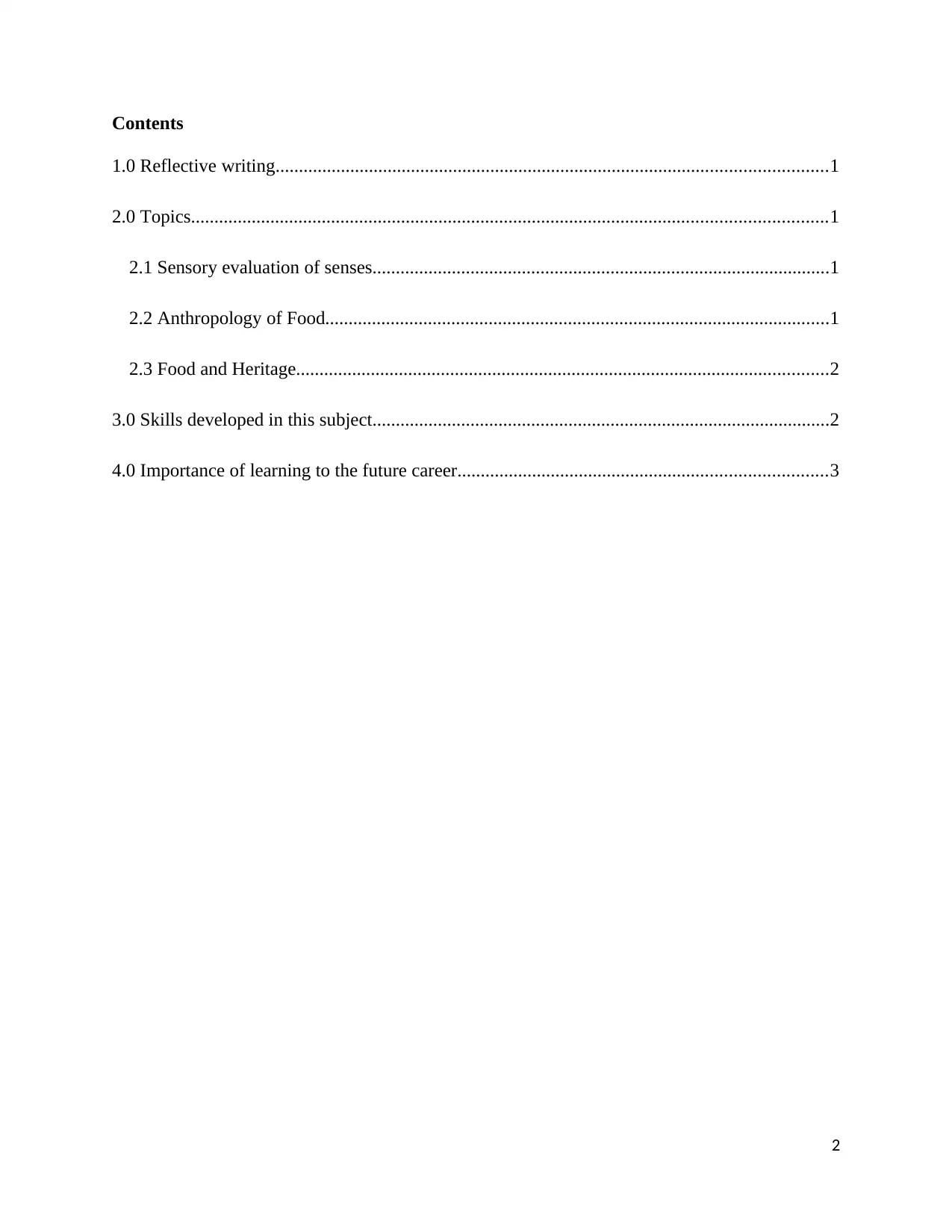
Contents
1.0 Reflective writing......................................................................................................................1
2.0 Topics........................................................................................................................................1
2.1 Sensory evaluation of senses..................................................................................................1
2.2 Anthropology of Food............................................................................................................1
2.3 Food and Heritage..................................................................................................................2
3.0 Skills developed in this subject..................................................................................................2
4.0 Importance of learning to the future career...............................................................................3
2
1.0 Reflective writing......................................................................................................................1
2.0 Topics........................................................................................................................................1
2.1 Sensory evaluation of senses..................................................................................................1
2.2 Anthropology of Food............................................................................................................1
2.3 Food and Heritage..................................................................................................................2
3.0 Skills developed in this subject..................................................................................................2
4.0 Importance of learning to the future career...............................................................................3
2
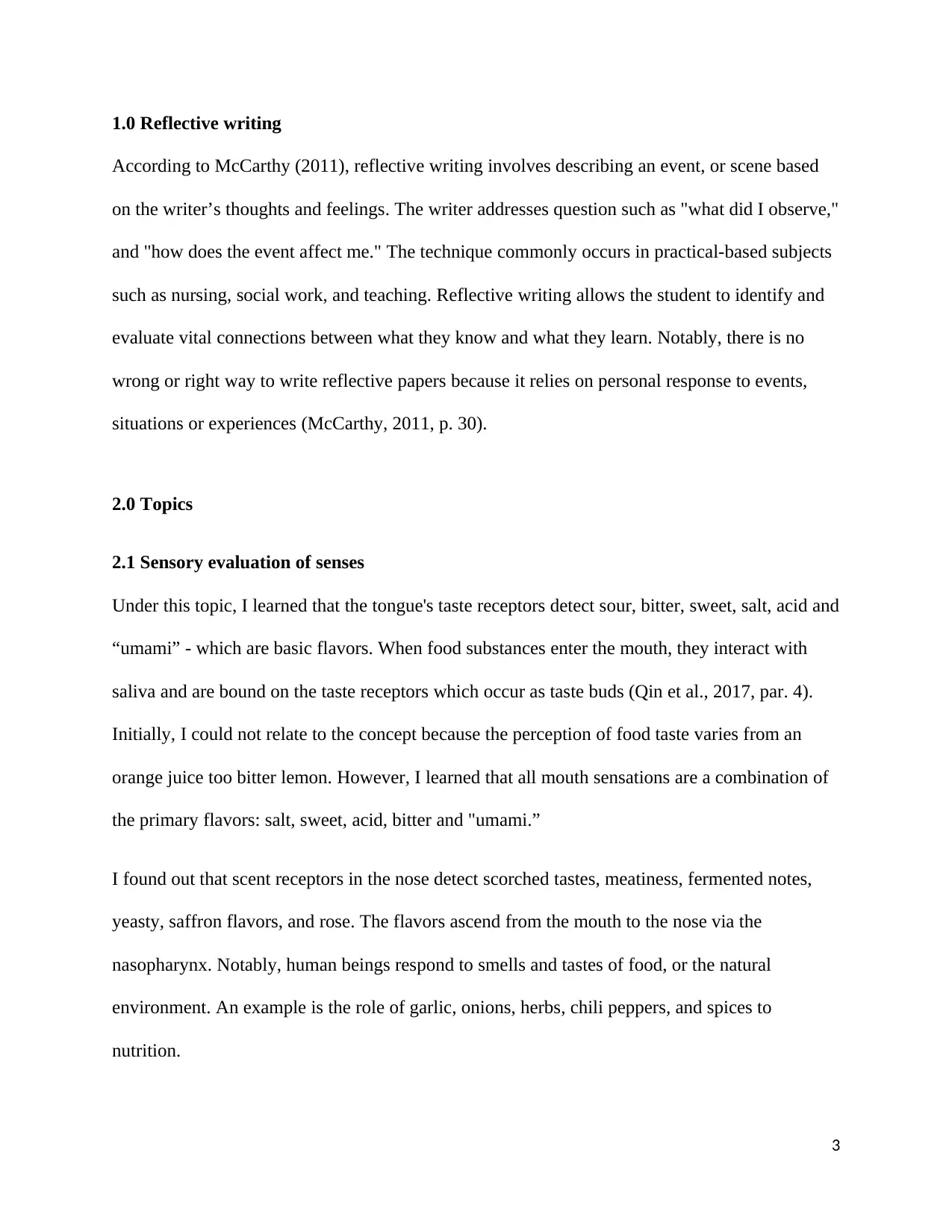
1.0 Reflective writing
According to McCarthy (2011), reflective writing involves describing an event, or scene based
on the writer’s thoughts and feelings. The writer addresses question such as "what did I observe,"
and "how does the event affect me." The technique commonly occurs in practical-based subjects
such as nursing, social work, and teaching. Reflective writing allows the student to identify and
evaluate vital connections between what they know and what they learn. Notably, there is no
wrong or right way to write reflective papers because it relies on personal response to events,
situations or experiences (McCarthy, 2011, p. 30).
2.0 Topics
2.1 Sensory evaluation of senses
Under this topic, I learned that the tongue's taste receptors detect sour, bitter, sweet, salt, acid and
“umami” - which are basic flavors. When food substances enter the mouth, they interact with
saliva and are bound on the taste receptors which occur as taste buds (Qin et al., 2017, par. 4).
Initially, I could not relate to the concept because the perception of food taste varies from an
orange juice too bitter lemon. However, I learned that all mouth sensations are a combination of
the primary flavors: salt, sweet, acid, bitter and "umami.”
I found out that scent receptors in the nose detect scorched tastes, meatiness, fermented notes,
yeasty, saffron flavors, and rose. The flavors ascend from the mouth to the nose via the
nasopharynx. Notably, human beings respond to smells and tastes of food, or the natural
environment. An example is the role of garlic, onions, herbs, chili peppers, and spices to
nutrition.
3
According to McCarthy (2011), reflective writing involves describing an event, or scene based
on the writer’s thoughts and feelings. The writer addresses question such as "what did I observe,"
and "how does the event affect me." The technique commonly occurs in practical-based subjects
such as nursing, social work, and teaching. Reflective writing allows the student to identify and
evaluate vital connections between what they know and what they learn. Notably, there is no
wrong or right way to write reflective papers because it relies on personal response to events,
situations or experiences (McCarthy, 2011, p. 30).
2.0 Topics
2.1 Sensory evaluation of senses
Under this topic, I learned that the tongue's taste receptors detect sour, bitter, sweet, salt, acid and
“umami” - which are basic flavors. When food substances enter the mouth, they interact with
saliva and are bound on the taste receptors which occur as taste buds (Qin et al., 2017, par. 4).
Initially, I could not relate to the concept because the perception of food taste varies from an
orange juice too bitter lemon. However, I learned that all mouth sensations are a combination of
the primary flavors: salt, sweet, acid, bitter and "umami.”
I found out that scent receptors in the nose detect scorched tastes, meatiness, fermented notes,
yeasty, saffron flavors, and rose. The flavors ascend from the mouth to the nose via the
nasopharynx. Notably, human beings respond to smells and tastes of food, or the natural
environment. An example is the role of garlic, onions, herbs, chili peppers, and spices to
nutrition.
3
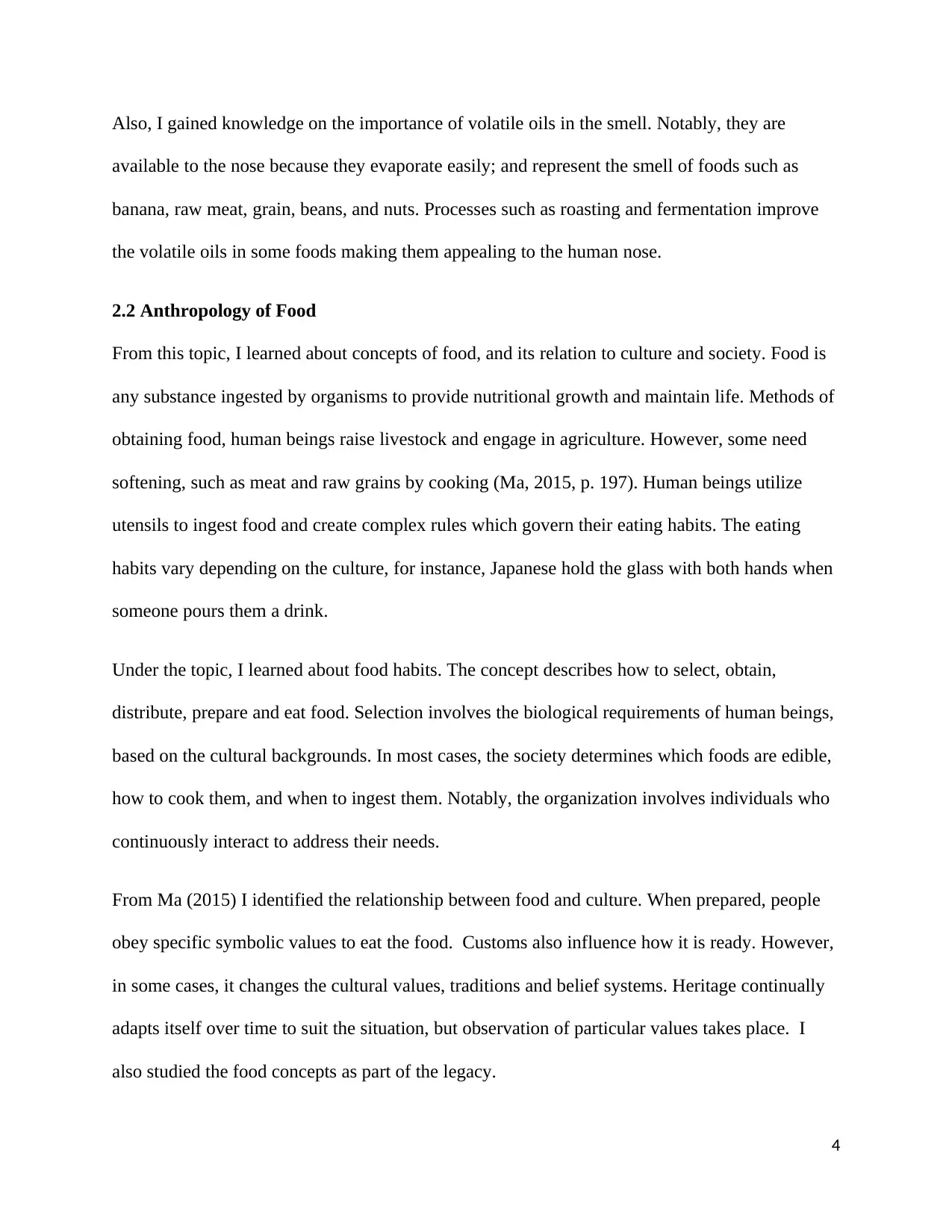
Also, I gained knowledge on the importance of volatile oils in the smell. Notably, they are
available to the nose because they evaporate easily; and represent the smell of foods such as
banana, raw meat, grain, beans, and nuts. Processes such as roasting and fermentation improve
the volatile oils in some foods making them appealing to the human nose.
2.2 Anthropology of Food
From this topic, I learned about concepts of food, and its relation to culture and society. Food is
any substance ingested by organisms to provide nutritional growth and maintain life. Methods of
obtaining food, human beings raise livestock and engage in agriculture. However, some need
softening, such as meat and raw grains by cooking (Ma, 2015, p. 197). Human beings utilize
utensils to ingest food and create complex rules which govern their eating habits. The eating
habits vary depending on the culture, for instance, Japanese hold the glass with both hands when
someone pours them a drink.
Under the topic, I learned about food habits. The concept describes how to select, obtain,
distribute, prepare and eat food. Selection involves the biological requirements of human beings,
based on the cultural backgrounds. In most cases, the society determines which foods are edible,
how to cook them, and when to ingest them. Notably, the organization involves individuals who
continuously interact to address their needs.
From Ma (2015) I identified the relationship between food and culture. When prepared, people
obey specific symbolic values to eat the food. Customs also influence how it is ready. However,
in some cases, it changes the cultural values, traditions and belief systems. Heritage continually
adapts itself over time to suit the situation, but observation of particular values takes place. I
also studied the food concepts as part of the legacy.
4
available to the nose because they evaporate easily; and represent the smell of foods such as
banana, raw meat, grain, beans, and nuts. Processes such as roasting and fermentation improve
the volatile oils in some foods making them appealing to the human nose.
2.2 Anthropology of Food
From this topic, I learned about concepts of food, and its relation to culture and society. Food is
any substance ingested by organisms to provide nutritional growth and maintain life. Methods of
obtaining food, human beings raise livestock and engage in agriculture. However, some need
softening, such as meat and raw grains by cooking (Ma, 2015, p. 197). Human beings utilize
utensils to ingest food and create complex rules which govern their eating habits. The eating
habits vary depending on the culture, for instance, Japanese hold the glass with both hands when
someone pours them a drink.
Under the topic, I learned about food habits. The concept describes how to select, obtain,
distribute, prepare and eat food. Selection involves the biological requirements of human beings,
based on the cultural backgrounds. In most cases, the society determines which foods are edible,
how to cook them, and when to ingest them. Notably, the organization involves individuals who
continuously interact to address their needs.
From Ma (2015) I identified the relationship between food and culture. When prepared, people
obey specific symbolic values to eat the food. Customs also influence how it is ready. However,
in some cases, it changes the cultural values, traditions and belief systems. Heritage continually
adapts itself over time to suit the situation, but observation of particular values takes place. I
also studied the food concepts as part of the legacy.
4
Secure Best Marks with AI Grader
Need help grading? Try our AI Grader for instant feedback on your assignments.
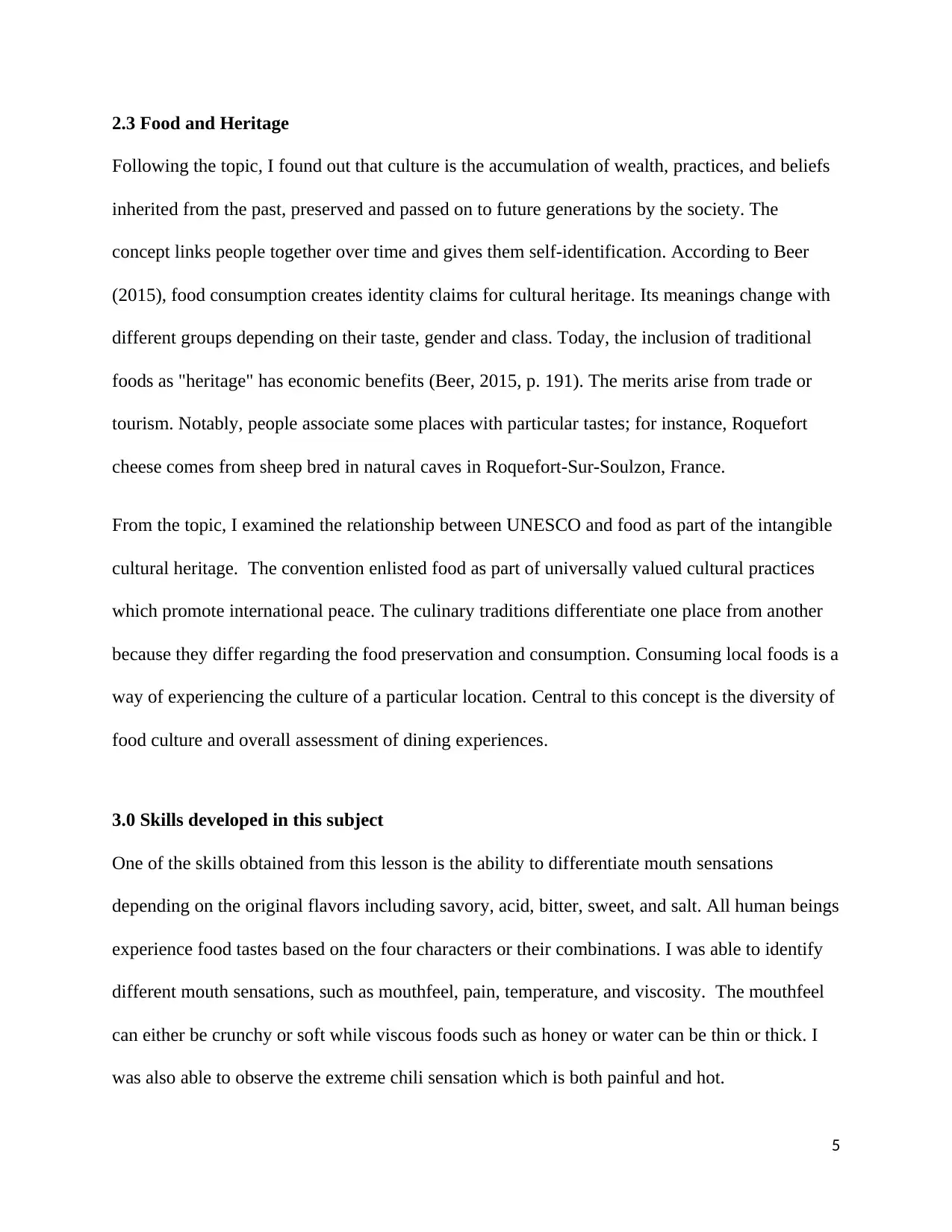
2.3 Food and Heritage
Following the topic, I found out that culture is the accumulation of wealth, practices, and beliefs
inherited from the past, preserved and passed on to future generations by the society. The
concept links people together over time and gives them self-identification. According to Beer
(2015), food consumption creates identity claims for cultural heritage. Its meanings change with
different groups depending on their taste, gender and class. Today, the inclusion of traditional
foods as "heritage" has economic benefits (Beer, 2015, p. 191). The merits arise from trade or
tourism. Notably, people associate some places with particular tastes; for instance, Roquefort
cheese comes from sheep bred in natural caves in Roquefort-Sur-Soulzon, France.
From the topic, I examined the relationship between UNESCO and food as part of the intangible
cultural heritage. The convention enlisted food as part of universally valued cultural practices
which promote international peace. The culinary traditions differentiate one place from another
because they differ regarding the food preservation and consumption. Consuming local foods is a
way of experiencing the culture of a particular location. Central to this concept is the diversity of
food culture and overall assessment of dining experiences.
3.0 Skills developed in this subject
One of the skills obtained from this lesson is the ability to differentiate mouth sensations
depending on the original flavors including savory, acid, bitter, sweet, and salt. All human beings
experience food tastes based on the four characters or their combinations. I was able to identify
different mouth sensations, such as mouthfeel, pain, temperature, and viscosity. The mouthfeel
can either be crunchy or soft while viscous foods such as honey or water can be thin or thick. I
was also able to observe the extreme chili sensation which is both painful and hot.
5
Following the topic, I found out that culture is the accumulation of wealth, practices, and beliefs
inherited from the past, preserved and passed on to future generations by the society. The
concept links people together over time and gives them self-identification. According to Beer
(2015), food consumption creates identity claims for cultural heritage. Its meanings change with
different groups depending on their taste, gender and class. Today, the inclusion of traditional
foods as "heritage" has economic benefits (Beer, 2015, p. 191). The merits arise from trade or
tourism. Notably, people associate some places with particular tastes; for instance, Roquefort
cheese comes from sheep bred in natural caves in Roquefort-Sur-Soulzon, France.
From the topic, I examined the relationship between UNESCO and food as part of the intangible
cultural heritage. The convention enlisted food as part of universally valued cultural practices
which promote international peace. The culinary traditions differentiate one place from another
because they differ regarding the food preservation and consumption. Consuming local foods is a
way of experiencing the culture of a particular location. Central to this concept is the diversity of
food culture and overall assessment of dining experiences.
3.0 Skills developed in this subject
One of the skills obtained from this lesson is the ability to differentiate mouth sensations
depending on the original flavors including savory, acid, bitter, sweet, and salt. All human beings
experience food tastes based on the four characters or their combinations. I was able to identify
different mouth sensations, such as mouthfeel, pain, temperature, and viscosity. The mouthfeel
can either be crunchy or soft while viscous foods such as honey or water can be thin or thick. I
was also able to observe the extreme chili sensation which is both painful and hot.
5
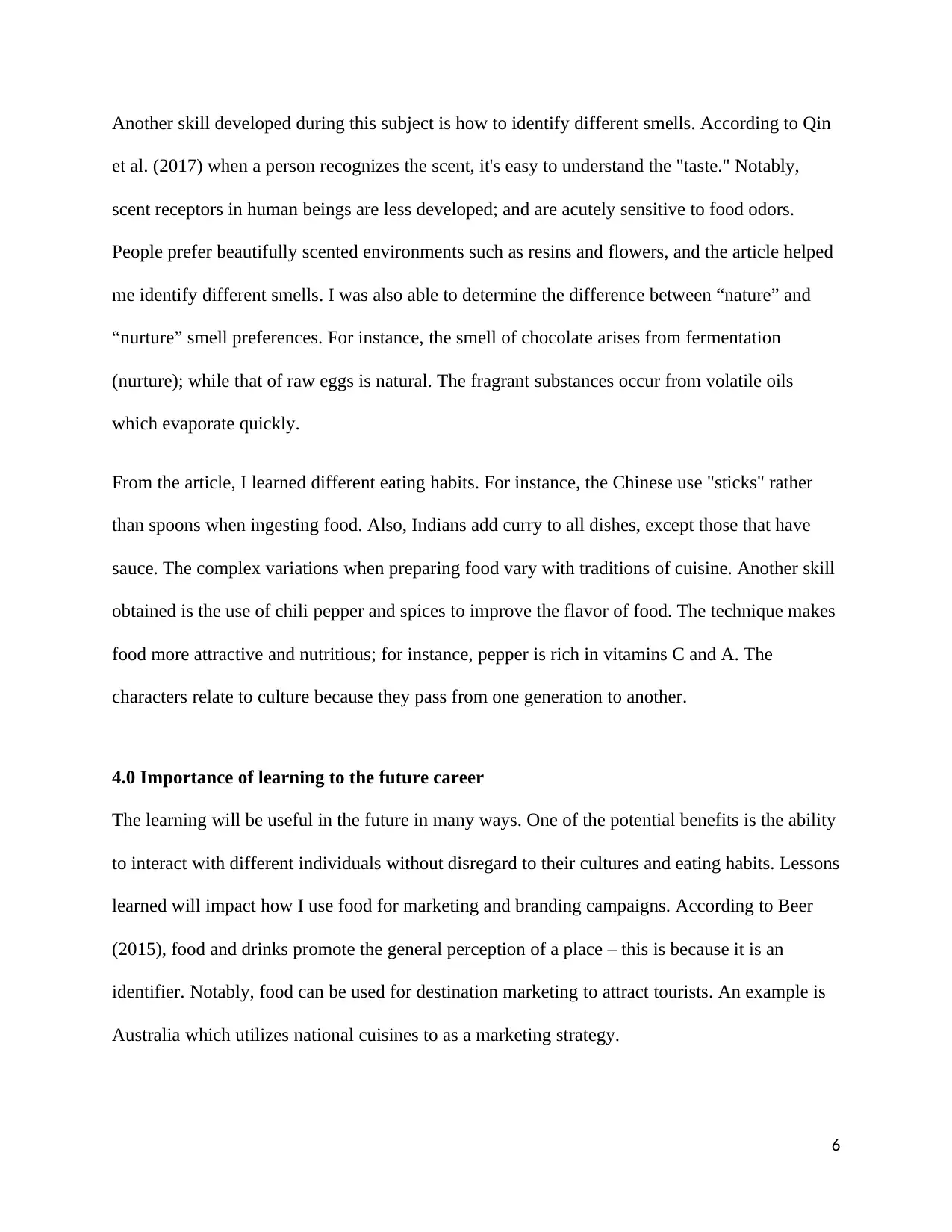
Another skill developed during this subject is how to identify different smells. According to Qin
et al. (2017) when a person recognizes the scent, it's easy to understand the "taste." Notably,
scent receptors in human beings are less developed; and are acutely sensitive to food odors.
People prefer beautifully scented environments such as resins and flowers, and the article helped
me identify different smells. I was also able to determine the difference between “nature” and
“nurture” smell preferences. For instance, the smell of chocolate arises from fermentation
(nurture); while that of raw eggs is natural. The fragrant substances occur from volatile oils
which evaporate quickly.
From the article, I learned different eating habits. For instance, the Chinese use "sticks" rather
than spoons when ingesting food. Also, Indians add curry to all dishes, except those that have
sauce. The complex variations when preparing food vary with traditions of cuisine. Another skill
obtained is the use of chili pepper and spices to improve the flavor of food. The technique makes
food more attractive and nutritious; for instance, pepper is rich in vitamins C and A. The
characters relate to culture because they pass from one generation to another.
4.0 Importance of learning to the future career
The learning will be useful in the future in many ways. One of the potential benefits is the ability
to interact with different individuals without disregard to their cultures and eating habits. Lessons
learned will impact how I use food for marketing and branding campaigns. According to Beer
(2015), food and drinks promote the general perception of a place – this is because it is an
identifier. Notably, food can be used for destination marketing to attract tourists. An example is
Australia which utilizes national cuisines to as a marketing strategy.
6
et al. (2017) when a person recognizes the scent, it's easy to understand the "taste." Notably,
scent receptors in human beings are less developed; and are acutely sensitive to food odors.
People prefer beautifully scented environments such as resins and flowers, and the article helped
me identify different smells. I was also able to determine the difference between “nature” and
“nurture” smell preferences. For instance, the smell of chocolate arises from fermentation
(nurture); while that of raw eggs is natural. The fragrant substances occur from volatile oils
which evaporate quickly.
From the article, I learned different eating habits. For instance, the Chinese use "sticks" rather
than spoons when ingesting food. Also, Indians add curry to all dishes, except those that have
sauce. The complex variations when preparing food vary with traditions of cuisine. Another skill
obtained is the use of chili pepper and spices to improve the flavor of food. The technique makes
food more attractive and nutritious; for instance, pepper is rich in vitamins C and A. The
characters relate to culture because they pass from one generation to another.
4.0 Importance of learning to the future career
The learning will be useful in the future in many ways. One of the potential benefits is the ability
to interact with different individuals without disregard to their cultures and eating habits. Lessons
learned will impact how I use food for marketing and branding campaigns. According to Beer
(2015), food and drinks promote the general perception of a place – this is because it is an
identifier. Notably, food can be used for destination marketing to attract tourists. An example is
Australia which utilizes national cuisines to as a marketing strategy.
6
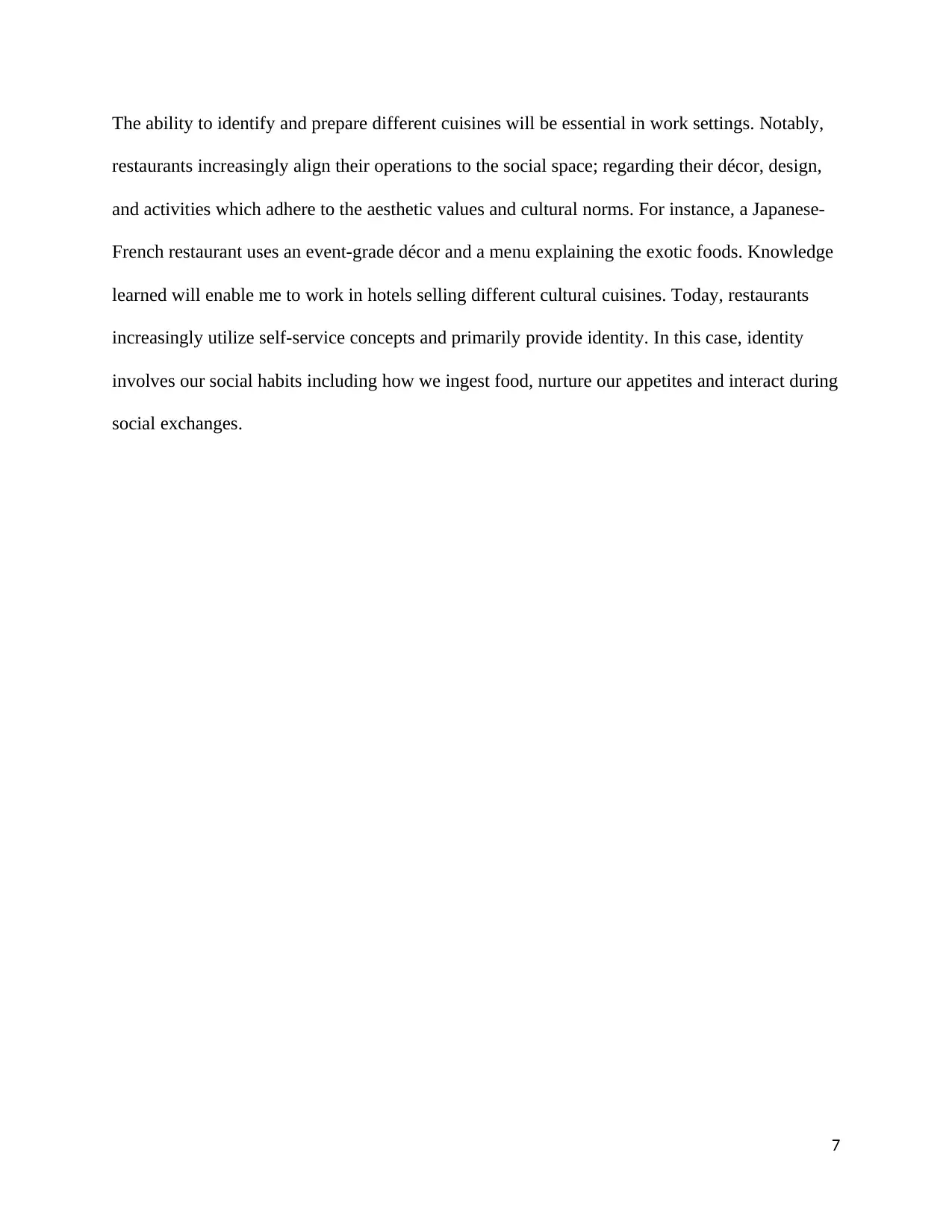
The ability to identify and prepare different cuisines will be essential in work settings. Notably,
restaurants increasingly align their operations to the social space; regarding their décor, design,
and activities which adhere to the aesthetic values and cultural norms. For instance, a Japanese-
French restaurant uses an event-grade décor and a menu explaining the exotic foods. Knowledge
learned will enable me to work in hotels selling different cultural cuisines. Today, restaurants
increasingly utilize self-service concepts and primarily provide identity. In this case, identity
involves our social habits including how we ingest food, nurture our appetites and interact during
social exchanges.
7
restaurants increasingly align their operations to the social space; regarding their décor, design,
and activities which adhere to the aesthetic values and cultural norms. For instance, a Japanese-
French restaurant uses an event-grade décor and a menu explaining the exotic foods. Knowledge
learned will enable me to work in hotels selling different cultural cuisines. Today, restaurants
increasingly utilize self-service concepts and primarily provide identity. In this case, identity
involves our social habits including how we ingest food, nurture our appetites and interact during
social exchanges.
7
Paraphrase This Document
Need a fresh take? Get an instant paraphrase of this document with our AI Paraphraser
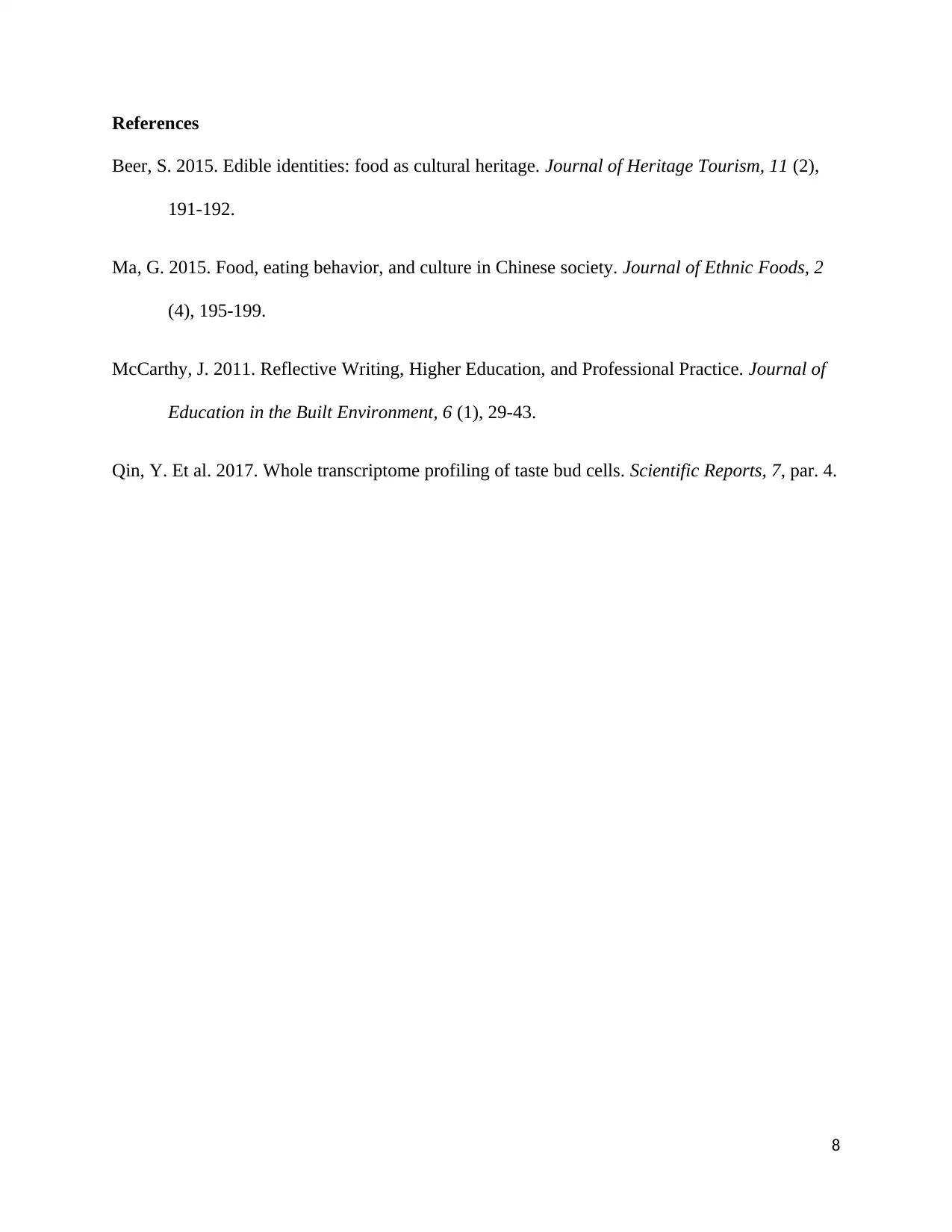
References
Beer, S. 2015. Edible identities: food as cultural heritage. Journal of Heritage Tourism, 11 (2),
191-192.
Ma, G. 2015. Food, eating behavior, and culture in Chinese society. Journal of Ethnic Foods, 2
(4), 195-199.
McCarthy, J. 2011. Reflective Writing, Higher Education, and Professional Practice. Journal of
Education in the Built Environment, 6 (1), 29-43.
Qin, Y. Et al. 2017. Whole transcriptome profiling of taste bud cells. Scientific Reports, 7, par. 4.
8
Beer, S. 2015. Edible identities: food as cultural heritage. Journal of Heritage Tourism, 11 (2),
191-192.
Ma, G. 2015. Food, eating behavior, and culture in Chinese society. Journal of Ethnic Foods, 2
(4), 195-199.
McCarthy, J. 2011. Reflective Writing, Higher Education, and Professional Practice. Journal of
Education in the Built Environment, 6 (1), 29-43.
Qin, Y. Et al. 2017. Whole transcriptome profiling of taste bud cells. Scientific Reports, 7, par. 4.
8
1 out of 8
Your All-in-One AI-Powered Toolkit for Academic Success.
+13062052269
info@desklib.com
Available 24*7 on WhatsApp / Email
![[object Object]](/_next/static/media/star-bottom.7253800d.svg)
Unlock your academic potential
© 2024 | Zucol Services PVT LTD | All rights reserved.